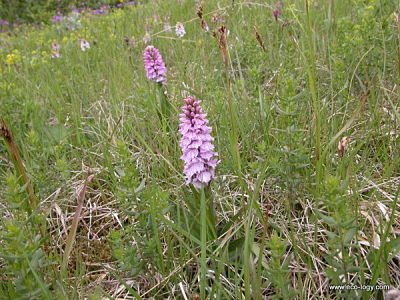BOTANY NEWS
Botanical Information
Welcome to this tenth edition of Botany News!
TOPICS:
- A note from the editor
- Growing by the hot springs
- North woods – land of spruce and fir
- Will food from plants save the small planet?
- A special announcement to Icelandic readers
- The flower box
Subscribers: 100+
Are you not subscribed? Join us now:
A note from the editor
HAPPY NEW YEAR! Welcome back to Botany News and a special welcome to new subscribers. Winter is here again, bringing Thorri and Goa, the Icelandic mid-winter months. Plants in the north are resting now, except perhaps for evergreens such as Juniper. Snow covers the ground and spring seems quite far away. However, it is perhaps a good idea to remind us of the green season and more southern places. This is the time to plan your vegetable or herb gardening activities in summer, plan a visit to the local botanical garden, prepare this summer´s tree planting at your summer cottage, start a botanical club in your neighbourhood or book one of our Botanical Day Tours in Iceland.
Botany News aims at providing articles of general botanical interest to readers from around the globe. You are welcome to send us a line, e. g., a letter or brief article, related to the general theme of this newsletter. If you like this ezine/newsletter perhaps, you could send your friends the link to subscribe to the FREE online ezine, Botany News! All suggestions for improving this ezine and the Eco-Logy.com website are welcome. Enjoy reading Botany News a growing ezine!
Growing by the hot springs
The geothermal areas in Iceland have unique vegetation including plants that are restricted to warm soils. Many geothermal sites also boast magnificient geological features. Hence, it necessary to carefully manage geothermal areas, preserving their special character. Recent development puts substancial pressure on these environments as industry and expanding construction press for more energy and heating.
Geothermal areas are of two major kinds so called high-heat and low-heat areas, this difference further shapes the geology and vegetation and dictates how geothermal areas may be utilized. Always be careful when exploring geothermal areas, tread carefully on the hot spring soil crust and enjoy watching the often delicate plants growing on warm soils. Here you might discover the pale blue flowers and shining, green leaves of Water Speedwell (Veronica anagalis-aquatica), the Small Adder´s Tongue (Ophioglossum azoricum) with thick, lanceolate leaves and green spikes, and the fragrant pink-flowered Hairy Thyme (Thymus praecox), that thrives on warm and dry soil.
Warm ground is common in the high-heat geothermal areas where the soil structure is favourable, e. g. gravel or porous rock. While hot springs may be inconspicuous in the summer, sometimes they are greener than the surrounding vegetation. In winter, however, these hot springs melt the snow around them, and are sometimes steaming hot. Living creature may exist even in almost boiling water, these strange living creatures are ancient forms of bacteria. Warm streams often flow from hot spring areas and make the downstream areas greener. Greenhouse farming and fish farming ponds in Iceland often benefit directly from the hot spring areas. A visit to explore the flora of one geothermal spot is included in the Botanical Daytours in Iceland.
North woods – land of spruce and fir
The dark green carpet across Canada, Alaska, Siberia, Russia and Scandinavia is the world’s vast boreal forest. In Canada the Balsam Fir (Abies balsameae) dominates the spruce-fir landscape in southeastern Canada and northeastern United States. Balsam Fir has a unique arrowhead symmetry, while it seldom reaches more than 20 m in height. The brittle, soft wood from this coniferous tree is mostly used for pulping.
The sturdy conifers are well defended against winds and cold weather and make modest demands upon the nutrient poor boreal soils. The conifers can withstand winds, frost and snow and capture in on the short growing season of the northern hemisphere. While Balsam Fir dominates the North American boreal landscape, other conifers that are able to withstand the adverse northern conditions include Norway Spruce (Picea abies), Scots pine (Pinus sylvestris), Siberian Fir (Abies sibirica), and White Spruce (Picea glauca). Siberian Fir is the most widespread of all firs, ranging across Russia, Siberia, and China. It grows taller than its North American relative, the Balsam Fir, reaching height of around 30 m.
Will food from plants save the small planet?
Cultivation of plants is needed as the main basis for producing more food for a growing human population. Careful planting and crop protection must be followed by the careful transport of the product to the market. Research is often need to cultivate improved varieties to provide more nutritious seeds, leaves and tubers. Beans are good examples of food consumed by man. These legumes provide a significant amount of much needed protein for humanity, while most other plants provide less protein. Cereals also differ in their protein content, some providing more protein than others.
Where ever plants are grown to supply food on a large scale, the plants must be suited to the stresses of the particular environment as well as seasonal changes. The improvement of plant product quality, such as protein content and of yield must go hand in hand for optimal production. Nowadays, many breeders are trying to increase the ability of plants to fix more nitrogen. This may be achieved though various strategies of plant breeding and could reduce the requirement for farmers to use artificial fertilizers for their fields.
The goal of plant breeding is to select plants with desired characteristic and make seeds and other plant material available to farmers, growers and planters to use on a large scale. The genetics behind plant breeding are, however, often complicated and even with the help of modern genetic engineering require extensive testing for a better crop plant material to be supplied to farmers.
While the most arable land around the world continues to supply most of the food needed for humanity, people in many countries still need to rely heavily on food crops produced in their own countries. Cultivating food crops in the expanding semi-arid and arid regions of the world remains one of the greatest challenges facing humanity.
A special announcement to Icelandic readers:
- Tilkynning!
Sendið okkur bréf og greinar um gróður til birtingar í næsta hefti Gróðurfrétta (Botany News), þið getið líka skoðað fyrri hefti á netinu. Þá er mögulegt að hafa tengla á ykkar vefsíður í blómakassa (flower box) fréttabréfisins eða á tenglasíðunni. Miðlið af ykkar eigin fróðleik til lesenda Gróðurfrétta um efni eins og jurtir og tré, ræktun plantna og plöntuskoðun. Þá má senda okkur tilkynningar og greinar um fjölbreytt efni tengt náttúru landsins, ferðalögum og garðyrkju. Sendið okkur endilega myndefni til birtingar frá síðastliðnu sumri af garðinum ykkar eða blómunum sem þið skoðuð síðastliðið sumar.
Fyrir þau ykkar sem hafið áhuga á náttúrlegum jurtavörum til gjafa má skoða á sölusíðu Þundar, te og jurtavörur frá Þund henta vel í gjafapakkann! Ekki er úr vegi að hjúfra sig á góðum stað, kannski við arin eða frammi í eldhúsi með bolla af heilsutei frá Þund! Vinsæla Bláa teið og Yerba mate heilsuteið fást núna og hægt er að panta þessi te og aðra vöru frá Þund og fá sendinguna í póstkröfu.
The flower box
Botany News welcomes letters and links from persons working on all aspects of botany, ecology and biology. We welcome input from persons working for botany, biodiversity and plant conservation around the world. Please, feel free to suggest new links to interesting botanical sites for the next Flower Box section.
The wintertime is an increasingly popular time to visit Iceland and explore the winter sky, the northern lights (Aurora Borealis), ski slopes and hills, and the thriving cultural life. Many, however, prefer to visit Iceland sometime between late April and late October. The summer is the best time to participate in nature tours such as the Botanical Tours in Iceland offered by Thund. Readers located in Iceland are reminded to check out Thund's sales page for fresh herbal and black teas and other products.
Why not send us a line or a more formal article. Short items on botany, horticulture and the many uses of plants are popular topics. Or send us a review on recent developments in your area of interest and upcoming botanical events. The articles/announcements need be no longer than 100-300 words. If needed or requested editing can be made of the language. We accept articles in Icelandic, English and Spanish, and will supply the editing required. However, articles that do not fit the profile or purpose of Botany News are not published. When included your article is still yours and you keep the full copyright.
Submit your Botany News article or announcement!
-----------------------------------------------------------------
Best wishes,
BOTANY NEWS is published by Thund, Reykjavik, Iceland.
February 3, 2008 -- Botany News, Issue #010



Fáðu nýjustu fréttir og tilboð frá Þund!
Get updates and special offers from Thund!











